The PRDecoded 2025 conference in Chicago brought together the industry’s sharpest minds to explore one urgent theme: how communicators can navigate uncertainty in an era of accelerating change.
Below is a summary of the sessions I attended and a breakdown of the messages I subsequently took away from the event.
Across sessions led by agency leaders, brand executives, and researchers, I found one message expressly clear: the rules are being rewritten, and PR is better positioned than ever to lead.
1. PR’s Defining Moment Has Arrived
The opening “State of the PR Nation” conversation between Richard Edelman of Edelman and Chris Foster of Omnicom PR Group set an assertive tone.
Edelman made an impassioned call for communicators to seize what he called “PR’smoment”. By which he was saying the rise of earned influence in AI-driven search. With Large Language Models (LLMs) pulling heavily from earned and organic media, PR has a measurable impact on reputation and revenue. Reputation driven from earned media is now the lead.
Foster echoed this sentiment, emphasizing that communicators must understand business fundamentals as deeply as they understand storytelling. “We own the story, and the story is the strategy,” he said, urging PR pros to lean into technology, not fear it.
Both agreed: this is not a time for timidity. It’s a time for PR to demonstrate its elasticity, its fluency in technology, and its ability to connect earned narratives directly to business outcomes.

2. Rebuilding Trust in a Skeptical World
In a panel on: Building Brand Trust in an Era of Skepticism, leaders from Feeding America, Conagra, and Allison shared a stark reality: trust is the most valuable — and fragile — currency brands hold.
Monica McCafferty of Feeding America argued that rebuilding it starts with authenticity. Conagra’s Jon Harris underscored the need to earn and sustain stakeholder trust consistently, noting that in an age of transparency, words alone no longer suffice.
The takeaway? As optimism fades in Western democracies, communicators must play a central role in restoring belief not through messaging spin, but through actions that align with brand purpose.
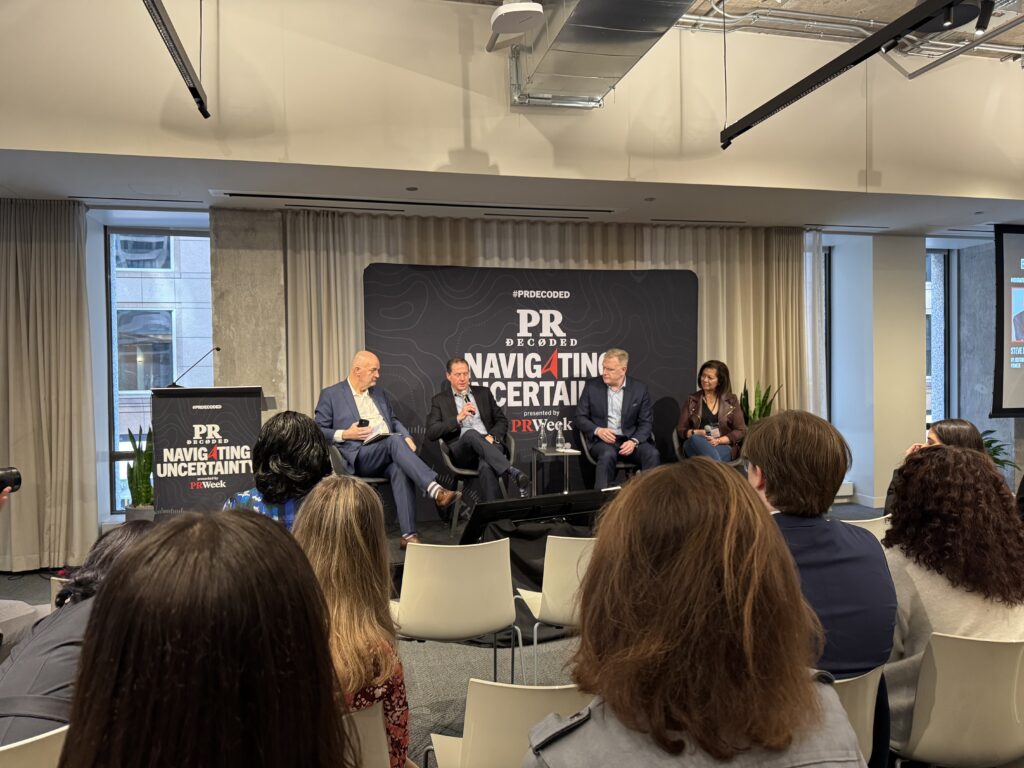
3. AI Is Reshaping the Communications Ecosystem
Several sessions reinforced that artificial intelligence is the next evolution of our craft, not the enemy
From Glenn Frates of PR Newswire calling for “information releases” structured to serve both human and machine readers, to Eileen O’Neill of Culligan reminding brands to “use data in smart ways,” the core message seemed to be: AI changes not what we say, but how we deliver and contextualize it.
Perhaps most eye-opening was Rob Bernstein of Ketchum’s presentation on Harnessing the Power of Search in the Era of Generative AI. He highlighted that GenAI represents the fastest technology adoption in history — 100 million users in two months — and it’s already redefining discovery.
In this “no-click search” world, GenAI doesn’t send people to your website; it becomes your website. Bernstein called it “the most powerful influencer of reputation,” urging communicators to analyze which stories are feeding algorithms and to optimize for visibility and sentiment.
His advice: Analyze → Interpret → Optimize. Because if you don’t answer questions about your brand, AI will, though you might not like the results.
4. Data Is the New Language of Reputation
In the Guardians of Reputation session, ADM’s Brett Lutz and Carma’s Orla Graham discussed how data is reframing reputation management.
Younger audiences, Graham noted, are deeply influenced by brand values. According to her, they don’t just buy products; they buy alignment. Lutz shared how ADM’s communications team uses data to make rapid strategic pivots, from reacting to political comments affecting corn prices to tracking how GenAI portrays their brand in search.
Similarly, in the session Reputation Is Currency, speakers described how their teams are investing in analytics and predictive modeling to quantify the business impact of communications,, underscoring how insights infrastructure now directly supports C-suite decision-making.
5. The Evolving Role of the CEO as Chief Communicator
The CEO as Lead Communicator panel and Kevin Warren’s keynote, Leadership and Aiming High, underscored the modern CEO’s role as a communicator first, operator second.
Warren, President & CEO of the Chicago Bears, shared how his decision-making philosophy, “player safety first” during the Big Ten’s pandemic-era challenges, stemmed from values-based clarity. Similarly, Monosol’s leaders spoke about agility and proactive signal detection as key to navigating crises like the “Tide Pod Challenge.”
The throughline: CEOs must not only embody transparency but also rely on communications teams who can sense emerging risks before they surface.
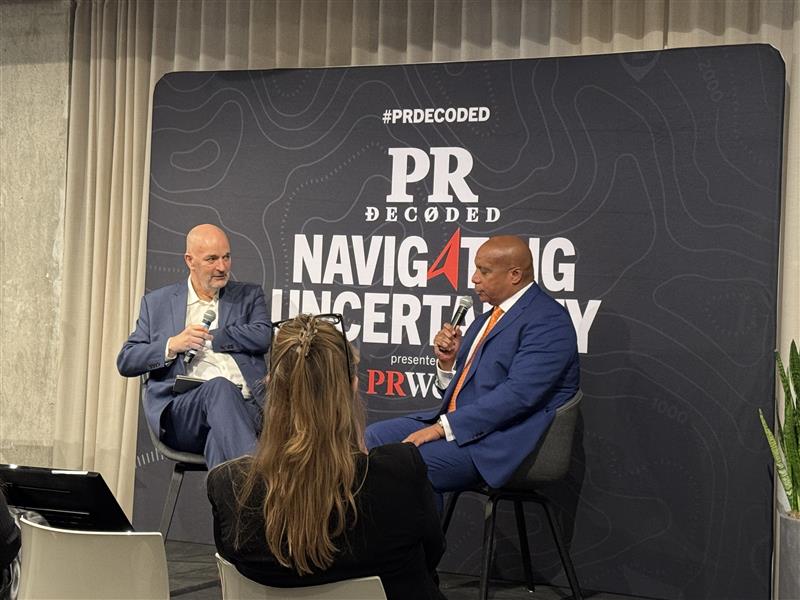
6. Strategic Responsiveness Is the New Crisis Playbook
In Cultural Flashpoints and the C-Suite, BMO’s Laura Micheli and Northwestern’s Jonathan Copulsky reframed crisis management as an ongoing cycle of intelligence and adaptation.
Copulsky drew parallels between brand resilience and military counterinsurgency strategy, emphasizing prediction, learning, and iteration rather than one-off crisis containment. Micheli shared how BMO’s culturally attuned campaigns, like #LoudBudgeting, turned potential financial anxiety into empowerment and relatability.
In summary: agility and foresight are foundational.
7. Influencers and Audiences Are Co-Creators of Trust
Finally, the Influencer Marketing Is the New Media session challenged the traditional view of influence.
GM’s Jessica Carmona and Burson’s Vikki Chowney argued that today’s most powerful influencers aren’t always celebrities.They’re the people who understand content and audience psychology. Chowney emphasized the importance of shared values and co-creation, while Reddit’s Adam Seligson noted that each platform requires a tailored, value-driven approach.
Basically, audiences can tell when brands “show up” authentically and they reward it.
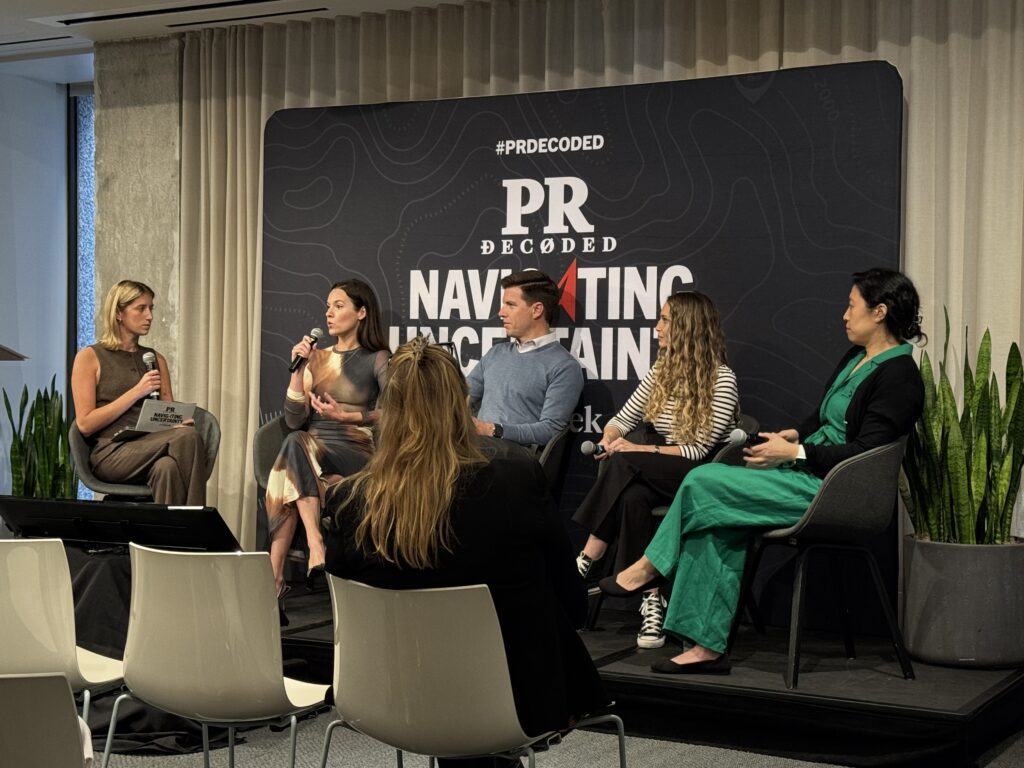
PR Must Lead Through Change
PRDecoded 2025 made one thing clear: uncertainty is not the enemy, but complacency sure is.
Communicators are the guardians of reputation, the architects of narrative truth, and now, the stewards of how AI perceives our brands. The future belongs to those who blend creativity with data, courage with curiosity, and empathy with precision, and as partners to communicators, we’re ready to help.
This is PR’s moment to lead — not by reacting to the world’s uncertainty, but by shaping what comes next.
By Jim Key, VP of Enterprise Solutions, PublicRelay
Media coverage of CEOs has become an important proxy for corporate reputation. Leaders are no longer just operators of their businesses; they are increasingly seen as brands themselves. PublicRelay’s 2025 edition of our CEO Index illustrates how executives are perceived in the media and, more importantly, how their presence affects their companies’ reputations.
The Index combines both perception and impact into a composite score. Perception reflects how the CEO is covered in the media (tone, reach, and visibility) while impact measures how that same coverage translates into reputation outcomes for the company. A consistent theme in the data is the widening gap between perception and impact. Many CEOs are highly visible and even well-liked, but their companies do not see a corresponding reputational benefit.

Visibility’s Double-Edged Sword
In the period leading up to Trump’s second term, CEO Perception and Impact Scores experienced a spike, as many high-profile executives sought visibility by engaging with Trump and his administration. At the time, this media-friendly approach—being seen at Mar-a-Lago or in high-profile meetings—was widely viewed as doing what was necessary for their companies, sometimes drawing even positive press coverage despite political differences. However, this honeymoon period proved short-lived. As Trump’s policies on tariffs began to impact businesses and tech leaders became embroiled in public controversies, such as Elon Musk’s erratic influence on Tesla’s narrative, the mood quickly shifted and scores dropped again. While visibility initially boosted CEO standing in the media, it soon backfired as those same meetings and donations led to sustained negative coverage. In other words, just “being visible” and courting influence is not a reliable long-term strategy.
This is where executive communications plays a critical role. For a CEO’s presence to have a positive effect on a corporate brand, it has to be carefully connected to the company’s enduring strategic narrative—otherwise, fleeting publicity can do more harm than good.
Archetypes That Reward Substance
The Index identifies nine CEO archetypes depending on certain combinations of Perception and Impact. These archetypes range from the well-aligned “Brand Ambassador” to the reputationally risky “Villain.” Two of the less flashy archetypes are particularly noteworthy:
- The Reluctant Hero: A leader who rarely seeks the spotlight but, when covered, emphasizes the company’s achievements and values. Their modest, authentic approach builds credibility and often improves the company’s reputation more than constant visibility would.
- The Steady Operator: A leader who communicates consistently and factually, without spectacle. This archetype may not drive headlines, but they project competence and stability, which are essential qualities when markets are volatile.
Both types represent CEOs who may not dominate media narratives but nonetheless contribute meaningfully to their company’s reputation by either positively impacting it, or at the very least, by not causing controversy.

Case Studies of Quiet Effectiveness
Recent case studies illustrate how understated leadership can deliver strong impact:
- Verizon’s Hans Vestberg has steadily climbed the rankings by embodying the Reluctant Hero archetype. Rather than chasing headlines, he has highlighted Verizon’s AI-powered service improvements and cybersecurity investments. Coverage of these efforts portrays the company as competent and forward-looking, reinforcing stability in a sector where trust in technology is critical. While Vestberg’s average Perception Score has seen a slight decrease since 2022, his Impact Score has jumped.
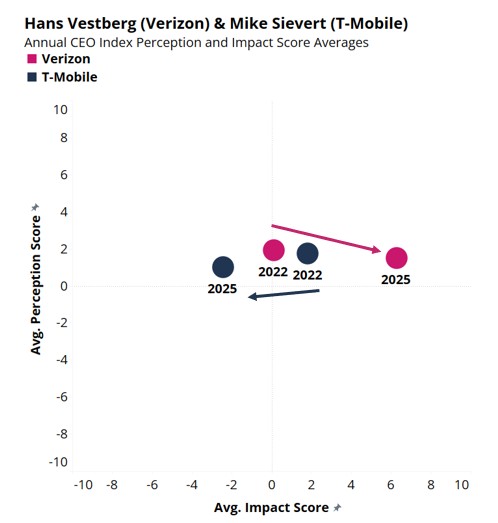
- In the finance sector, several CEOs have successfully shifted archetypes by dialing back personal visibility and focusing on results. Goldman Sachs’ David Solomon, once criticized for his DJ side-gig and off-beat return-to-office comments, retreated from that persona and returned to a more traditional leadership profile. Solomon’s quieter public profile signaled a retreat from Villain territory toward a more stable archetype.
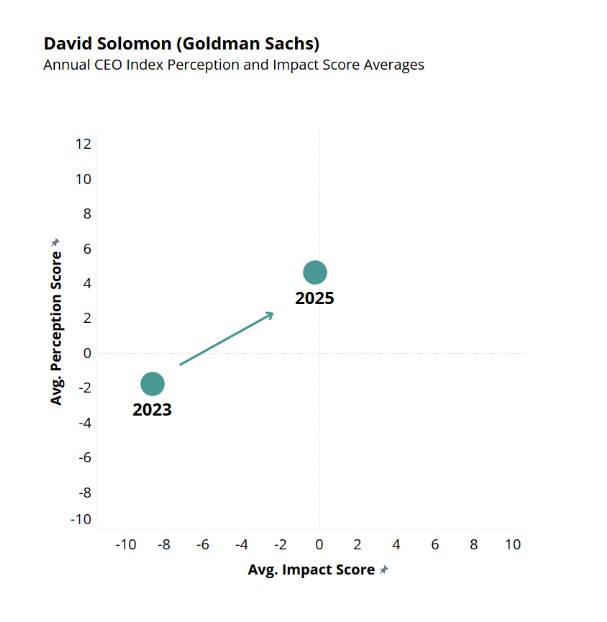
These examples demonstrate that quiet effectiveness is not about avoiding the media altogether, but about ensuring that media coverage consistently reinforces the company’s narrative rather than overshadowing it.
Why Quiet Can Be Effective
Some CEOs score higher on impact than perception. They are not household names like Elon Musk or Mark Zuckerberg, nor do they command constant media attention. Instead, they focus their communication on company performance, innovation, and stakeholder value. Their impact scores suggest that measured visibility, tied directly to the brand’s story, can be just as valuable as charisma or controversy.
This matters at a time when CEOs are under intense pressure to serve as steadying figures. The public looks to them for signals of stability in the face of economic and geopolitical challenges. For executive communications teams, the task is to align messaging with that need, ensuring that even modest media appearances reinforce the company’s strengths and resilience.
Implications for Executive Communicators
The data suggests that visibility alone is no longer a reliable strategy. Executive communications teams should consider:
- Evaluating the CEO’s current archetype and its alignment with company reputation goals.
- Building strategies for high-impact, low-frequency engagements, especially when the CEO naturally fits the Reluctant Hero or Steady Operator mold.
- Monitoring both perception and impact scores over time to identify when a CEO’s presence may be overshadowing or misaligned with the corporate narrative.
- Studying sector-specific examples, such as finance and telecom CEOs, who have shifted archetypes by recalibrating their communications strategies.
Conclusion
Not every CEO will become a larger-than-life media figure, and that can often be for the best. The 2025 CEO Archetypes Index shows that quiet effectiveness can be just as valuable, if not more so, for companies seeking stability and trust. Executive communicators who recognize and support this kind of leadership can help ensure that a CEO’s media presence, however modest, delivers meaningful impact for the brand.
Download the full 2025 CEO Archetypes Report to explore all nine archetypes and learn how they shape both perception and impact.
Author: Kay Kavanagh, Director of Research
Getting Started
Since we last discussed this topic, AI has become a present-day necessity in PR & Communications. But knowing you need to use it and knowing where to begin are two vastly different things.
Many communications leaders feel the pressure to adopt AI but aren’t sure how to start, where to proceed with caution, or what “good” looks like. That’s why PublicRelay is helping clients simply begin by offering a low barrier but extremely strategic way to add AI into their toolkit.
Here’s what we’ve learned from working directly with communications teams using AI every day: what is working, where to watch out, and how a hybrid human-AI approach can help you move forward with clarity.
AI Is Reshaping Communications, But It’s Not a Silver Bullet
Artificial intelligence is now a foundational capability for modern PR and Communications teams. Used strategically, AI is reshaping how communicators gather insights, track narratives, and respond to risk. But we’ve seen firsthand: AI is only as strong as the strategy—and human expertise—behind it.
On its own, AI lacks the context, precision, and strategic nuance required to meet the high stakes demands of today’s media environment. That’s why the most effective PR teams are embracing a hybrid model that combines the speed and scale of AI with the insight and accuracy of human expertise.
Opportunity: Scale and Speed in a Noisy World
Every minute, millions of posts, photos, and videos are shared, viewed, and watched across social media channels like X, Instagram, TikTok, and YouTube. Joining nearly a million news articles published each day, the scale of public discourse becomes overwhelming. Parsing this vast landscape for relevant content, sentiment, stakeholder impact, and reputational risk is far beyond the capabilities of traditional manual analysis.
This is the clearest value of AI: helping communications teams keep pace with an information environment that simply moves too fast for humans alone.
Its ability to process and classify massive volumes of unstructured data quickly makes it ideal for surfacing high-level trends, monitoring message pickup, benchmarking competitors, and identifying sudden shifts in tone or topic. This kind of speed and scale is essential to helping communicators respond with agility and insight.
Pitfall: The Context Gap
Yet AI has limitations. Despite its speed and efficiency, it lacks the bespoke context and strategic understanding that communications leaders rely on to make high-quality decisions. AI models can hallucinate. They can miss nuance. And they struggle with the ambiguity and complexity that often define reputational risk or opportunity.
That’s why leading communications functions aren’t replacing human expertise, they’re strategically augmenting it. A hybrid model that pairs AI with human intelligence offers the best of both worlds: scale without sacrificing relevance. Humans continue to play a vital role in interpreting data, validating insights, and applying contextual understanding that machines alone can’t deliver.
PublicRelay helps clients walk that line, giving them confidence to start their AI journey knowing they’re supported by both responsible AI use and human judgment.
Start Here: Smart Ways to Add AI to Your Communications Toolkit
You don’t need to be an expert or completely overhaul your workflow to begin using AI. Here are a few ways PublicRelay is helping clients integrate AI responsibly:
Media Measurement at Scale
AI enables us to track and measure media coverage across millions of sources. Key messages, executive visibility, peer comparisons, and issue-based trends can all be monitored with speed and consistency. Human oversight ensures the accuracy and relevance of that data, especially when it comes to interpreting tone, intent, or subtle shifts in narrative.
Narrative Intelligence
Advanced AI models can now help identify not just what’s being said, but how topics are connecting across the media landscape. By surfacing patterns in sentiment, stakeholder voice, and narrative evolution, our team can help communicators spot emerging storylines, understand how public opinion is forming, and map the themes likely to dominate coverage.
Predictive Signals and Risk Detection
One of the most powerful developments in AI for communications is predictive modeling. By examining real-time indicators alongside historical media trends, AI can flag stories likely to accelerate in visibility (whether they represent a reputational risk or a positive opportunity). Early warning systems give communications leaders the ability to prepare responses, shape narratives, and steer internal alignment before the conversation takes off.
We’ve seen this approach help clients properly navigate media crises and also spot moments of opportunity early.
Custom Intelligence for Strategic Alignment
AI is most effective when its capabilities are tailored to the unique context of a business. Communications teams are increasingly building custom analysis frameworks aligned to their structure, goals, and stakeholders. We work with our clients to design bespoke AI applications that mirror their internal priorities, whether that means tracking specific narratives, evaluating executive visibility, or benchmarking key competitors.
Think of this as turning AI into your AI.
A Feedback Loop for Continuous Improvement
The most successful implementations of AI in PR evolve. Human experts serve as the feedback mechanism that keeps AI models accurate and relevant, particularly as business objectives shift or media landscapes change. This consistent feedback loop is a core part of how we ensure our clients’ insights remain both actionable and aligned with what matters most to their organization.
You Don’t Have to Be First, You Just Have to Begin
If you’re not already using AI, you’re not behind, you’re just ready to start. At PublicRelay, we’ve seen that the most successful teams aren’t the ones who jump headfirst into AI with flashy tools. They’re the ones who take a smart, strategic first step that aligns with their needs and grows over time.
The Future of Communications Is Hybrid
The future of Comms is about combining the precision of people with the power of technology. AI enables communications teams to scale analysis, anticipate emerging narratives, and respond with agility. Human expertise ensures that what’s surfaced is meaningful, accurate, and strategically useful.
In a world where the pace of information shows no signs of slowing, this hybrid approach should be standard. It transforms communications teams into strategic advisors equipped not just to monitor what’s happening but to shape what happens next.
You don’t have to master AI overnight. But you can start building a smarter, more proactive PR function.
Want to explore how AI can support your communications goals without overcomplicating your workflow? Let’s talk.
PublicRelay partners with leading brands to deliver the insight and clarity their teams need to lead.
Author: Liz Hogan, Senior Solutions Engineer
Communicators are under increasing pressure to prove the value of their earned media efforts. But what makes media coverage truly valuable?
For years, the industry has leaned on metrics like volume, impressions, and AVE, numbers that often favor quantity over quality. While these metrics have their place, they fall short of capturing the true impact of media coverage. The ever-present push to prove value requires a shift in the conversation from how much coverage you’re getting to how much it actually matters.
Beyond Volume: Defining Media Value
True media value lies in context, quality, and strategic relevance. A single mention in a high-authority outlet that aligns with your brand’s key messages can be more impactful than dozens of low-quality clips. To understand this deeper value, we need to look at media coverage through a more sophisticated lens that considers not just visibility, but significance.
PublicRelay’s Media Quality Score (MQS) does that.
By combining five dimensions of media quality into one metric, MQS offers a contextualized, actionable view of media performance.
The Five Dimensions of Media Quality
To succeed in the GEO era, comms teams must rethink how they craft and distribute content. Here are four strategies to get started:
1. Outlet Credibility
Not all media outlets are created equal. Communicators should be able to assess the authority and prominence of the source, whether it’s a national publication, a respected trade journal, or a niche blog.
Example: A feature in The Wall Street Journal carries more weight than a mention in a low-traffic blog. Knowing definitively which outlet(s) move the needle most helps you prioritize higher-impact placements.
2. Topic Incidence
This measures the depth and richness of coverage. It’s not just about being mentioned; it’s about how thoroughly your brand is discussed and whether your strategic messages are front and center.
Example: An article that explores your company’s innovation strategy in detail would score higher than one that simply lists your name among competitors.
3. Tonality
Unlike machine-generated sentiment scores, MQS uses human analysts to evaluate tone with nuance and context. It also compares your brand’s tone to that of competitors.
Example: If your brand is portrayed more positively in a direct comparison to a peer, that’s more impactful than simply getting listed side-by-side in the same context.
4. Social Engagement
Earned media doesn’t stop at publication. MQS tracks how much traction your coverage gets on platforms like Facebook, X, and Pinterest.
Example: A story that sparks conversation and shares on social media amplifies your reach and influence.
5. Distribution
This component evaluates how widely an article is syndicated and republished.
Example: An article picked up by a wide syndication network and republished across industry sites has broader reach and impact than a single publication.
Media Quality Score: A Holistic Solution for Strategic Communicators
In sum, MQS is a strategic compass that helps communications leaders:
- Benchmark performance over time and against competitors
- Identify strengths and weaknesses in media strategy
- Present clear, compelling results to executives
- Focus efforts on what truly moves the needle
In a world where media noise is constant, MQS helps you tune into the signals that matter most, making it easier to understand the value your team is bringing to the table.
Contact the PublicRelay team to learn more about our Media Quality Score.
Author: Medha Chandorkar, VP of Product Management
How AI is Changing Search and PR: The AI Inflection Point
In just a few short years, artificial intelligence has evolved from a buzzword to a business-critical capability in public relations. What began as cautious experimentation with AI-generated headlines has matured into a full-scale transformation of how PR and Communications teams operate, measure success, and shape narratives.
Increasingly, there are indicators that traditional media monitoring and SEO are not going to be sufficient in the AI future. AI-generated content discovery tools (like ChatGPT, Perplexity, and Google’s AI Overviews) are playing a growing role in how audiences find information.
We’re now seeing Generative Engine Optimization (GEO) emerge, i.e., the discipline of optimizing content to appear in AI-generated answers. As generative AI search results overtake clicks and AI-first search is normalized, GEO is quickly becoming an important part of the strategy for comms teams that want to stay visible and influential.
That said, while GEO is redefining visibility, it’s just one part of a much larger story. The real opportunity lies in how AI is helping PR teams optimize their entire communications strategy.
GEO as the Next Frontier: What it is and Why It Matters for PR & Communications
The emergence of GEO marks a pivotal shift in how communications teams must think about visibility and influence in an AI-first world.
Generative Engine Optimization (GEO) is the practice of structuring and distributing content in ways that increase the likelihood of being cited, summarized, or surfaced in AI-generated responses.
Unlike traditional SEO, which focuses on ranking in search engine results pages (SERPs), GEO is about being part of the answer, i.e., the actual text that AI tools generate in response to user queries.
- SEO = visibility through links.
- GEO = visibility through language.
This distinction matters. In a world where users increasingly rely on AI to summarize the web, being cited in the answer itself is more powerful than being buried in a list of links. GEO shifts the goal from clicks to influence.
Generative Engine Optimization in PR
To succeed in the GEO era, comms teams must rethink how they craft and distribute content. Here are four strategies to get started:
Prioritize Earned Media in Authoritative Outlets
AI models are trained on inputs from high-quality, trusted sources. That means coverage in outlets like AP, Reuters, and respected trade publications is more likely to influence and be surfaced in AI-generated answers. GEO starts with strong earned media.
Ensure Semantic Consistency
Use consistent language for brand names, spokespersons, and key messages. AI models rely on patterns, so the more consistent your messaging, the more likely it is to be recognized and reused.
Structure Content for AI As Well As Your Audience
Think like a machine. Use clear headings, concise summaries, and fact-based language. Avoid jargon. Make it easy for AI, and your human readers, to extract meaning and context from your content.
Leverage Thought Leadership
AI tools favor authoritative voices. Publishing original insights, expert commentary, and data-backed perspectives across channels increases the chances your content will be cited in generative responses.
Adapt or Be Ignored
As GEO reshapes how audiences discover content, PR metrics must evolve too.
- From pageviews → to presence in AI-generated answers
- From backlinks → to brand mentions in LLM outputs
If your brand isn’t showing up in AI-generated answers, you’re missing clicks and influence. While this can be a stressful new KPI to have to consider, AI can also help. Specifically, AI and human intelligence. The future of AI relies on high-quality data – which is foundational to all high-quality outcomes. With the right data and analytics, PR and Communications teams can combine the speed and scale of AI with the nuance and insight of human expertise to understand media coverage at scale while ensuring accuracy, quality, and a bespoke strategy that drives real impact.
You get the scale of AI and the storytelling power of human intelligence delivered intentionally to help your brand show up in high impact earned media, and therefore, is Generative Engine Optimized.
Is your brand showing up the way you want it to (or at all) in AI answers? If not, it’s time to optimize. Contact the PublicRelay team.
Author: Travis Day, CRO
In media monitoring and analysis, your company’s media coverage refers to every published article, social media post, or broadcast clip that mentions your company. PublicRelay’s unique software scrapes the internet for a customized aggregation of your company’s media mentions. Then, our human analysts read and analyze this coverage by categorizing the content using our relational tagging system.
In this comprehensive guide to PublicRelay’s proprietary tagging system, you’ll learn:
- What is tagging?
- The difference between tagging and keyword tracking.
- How relational tagging helps you meet your Communications goals.
Actionable Insights to Elevate Your Communications:
Benchmark analysis from PublicRelay.

PublicRelay hosted a live webinar with our SVP of Analytics, Ted Ziemer, and Director of Analytics, Azhar Unwala, to discuss key insights that emerged in the communications landscape of 2022. As your trusted advisor, we want to share actionable insights to help you guide your brand strategy.
Most media analysis relies on automation, but we’ve found that including a human element can provide insights that truly impact your business. We created this exclusive, virtual opportunity to share the results of our communications landscape report that highlights what a human-augmented technology approach can achieve.
By registering for our event, you will learn best practices of top-performing companies so you can elevate your communications strategy and benchmark your brand’s performance against the best in the industry.
- How using your CEO as a spokesperson can make an impact on corporate reputation
- How to tailor your communications strategy to take advantage of the topics your audience cares about while protecting your brand against harmful media coverage
- How best to engage with major stories that shaped the communications landscape of 2022, like inflation, the overturning of Roe v. Wade, and the Russia-Ukraine war

Can technology provide more accurate analysis than humans?
A PublicRelay Partnership with MIT finds that the answer is no.
A study that set human media analysis head-to-head with MIT’s natural language technology processors found that automated solution only had:
- 9% accuracy on detecting key message presence
- 20% accuracy on allocating the correct sentiment
- 33% accuracy on highlighting the precise experience of the customer
Background
Social media analysis is one of the fastest-growing areas of text analytics.
For efficiency and economical reasons, most media analytics providers in the space rely on automated technology to extract emotion and sentiment. But can technology actually provide more accurate text analysis than a human?
In collaboration with Toyota Motor NA Energy & Environmental Research Group, PublicRelay and the intelligent minds at the Massachusetts Institute of Technology (MIT) Analytics Lab set out to find an answer.
The Project
Over the course of three months, the MIT Analytics Lab team tested various technologies to:
- Understand which topics car enthusiasts are discussing in relation to alternate-fuel vehicles on Twitter
- Identify “significant” tweets based on topic inference from above.
The goal was to identify tweets that demand further tracking or direct engagement, and formulate messaging that Toyota might use to drive social media conversations themselves.




The Technology
- MIT built two different modeling approaches to interpret the data– Latent Dirichlet Allocation (LDA) and a Biterm Topic Model (BTM).
- For both processes, the MIT team indicated to the machines which words were topically important.
- The processes would then clean up the tweet text by isolating only the most “important” words and analyze those for key messages, sentiment, and experience according to pre-set definitions.

The Results
- The accuracy of the technological solution versus the human in three key measured attributes was only 9% (key message), 20% (sentiment), and 33% (experience).
- While the technology may be useful in eliminating irrelevant posts before humans analyze them, the MIT team found that 80% of their machine-learning work was simply data clean-up — the computer algorithms had a hard time deciphering commonly used symbols in on Twitter, like @, #, and even text emojis.
- Lastly, the study showed how technology did not handle rapidly changing topics well:
- Analysis over a short time frame fails to detect the quickly‐dissipating influence of one‐off news events and crises.
- Rapidly emerging issues or breaking news such as the Tesla autopilot crash were slow to be reflected in a model.